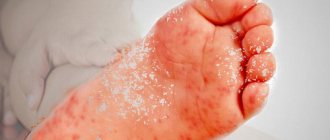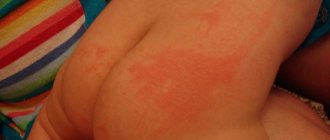Allergies in children are as common as colds. While many parents may find it intuitive to distinguish between runny nose symptoms and allergies, in some cases it can be quite challenging, especially if symptoms appear when plants are in bloom.
If persistent symptoms of a runny nose, cough, sneezing and itchy eyes persist for more than a week while pollen is flying, then an allergy is most likely to blame for your runny nose. But with one important caveat - if your child is an infant or a toddler under the age of three, then he is much less likely to have seasonal allergies. While there are exceptions to every rule, most children don't begin to experience hay fever symptoms until they are 3 or 4 years old, after they have been seasonally exposed to large amounts of pollen and have developed a sensitivity to the allergen. Interestingly, pollen allergies and food allergies are linked: more than half of children who suffer from hay fever also have food allergies.
What are the causes of hives in a child?
It is impossible to answer this question in a few words. It can be caused by a huge number of irritants, so the source of the problem must be sought in each specific case. Here are just some of the causes of this disease.
Allergic
A wide range of food products, in particular fish, shellfish, eggs, nuts, tomatoes, strawberries. Various food additives - dyes, preservatives (sulfites, salicylates) and others.
Toxic
Bites from wasps, bees, mosquitoes, fleas, spiders and other insects. Contact with certain plants, in particular nettles. Contact with jellyfish and other marine inhabitants.
Physical
Mechanical influences such as pressure or vibration. Exposure to cold, heat, sunlight. High physical activity, stress.
Pseudo-allergic
Medicines, in particular penicillin drugs, non-steroidal anti-inflammatory drugs (for example, aspirin), some antibiotics, insulin, radiocontrast agents and others.
Autoimmune
Autoimmune reaction.
Idiopathic
For no apparent reason.
In addition to the direct causes listed in the table, urticaria in a child may be associated, i.e. be a symptom of another disease. Sometimes it occurs as one of the manifestations of a bacterial, viral or fungal infection, a deficiency of certain enzymes in the baby’s body, or hereditary diseases.
As you can see, there are a lot of reasons. The only good thing is that it occurs very quickly after exposure to the stimulus, so it is often possible to calculate it “hot on its heels.”
Causes of the rash
The most likely causes of abdominal rashes in childhood are:
- Irritation of an allergic nature. There are a lot of allergens that provoke a reaction from the immune system. A skin rash can be caused by formula or mother's milk (if the mother herself consumed allergenic foods). The main method of therapy for allergic rashes is identifying the allergen and eliminating it.
- Infectious lesions of the body. In such cases, the rash is usually severe and is accompanied by other symptoms (high fever, signs of general intoxication of the body).
- Impact of external factors. Prolonged contact with wet underwear and untimely diaper changes can cause prickly heat in infants and older children.
- Insect bites - mosquitoes, bedbugs, fleas.
- Taking medications - any medications can have side effects in the form of rashes, itching and other manifestations.
You should not try to determine the cause of the rash on your own - a qualified specialist in childhood diseases will do this more effectively. If a rash on a child’s stomach is accompanied by additional symptoms, calling a doctor is mandatory.
Read also: Allergies in children
Polina Vasilyeva
dermatologist
| Separately, I would like to talk about the manifestations of urticaria in pregnant and nursing mothers and figure out whether it is dangerous. The first appearance of urticaria during pregnancy is a fairly common occurrence, and the reason for this is excessive sensitivity to placental proteins, as well as concomitant pathologies during pregnancy (gestational diabetes, for example). If a woman was already “familiar” with urticaria before pregnancy, then in some cases her condition may worsen during pregnancy due to hormonal changes. It is important to remember that most often urticaria does not have any negative effect on the fetus (during pregnancy) and the newborn (during breastfeeding), but you need to be careful with taking medications (antihistamines and hormonals) during these periods. Be sure to consult with your healthcare provider. |
Children under two years of age usually suffer only from the acute form. Between the ages of 2 and 12 years, urticaria sometimes becomes chronic, but more often it still occurs in an acute form. In adolescence, the chronic form takes precedence over the acute form.
Treatment and prevention of allergies
According to the latest WHO recommendations, the basis for the prevention of food allergies in children is breastfeeding. Children who receive exclusively breast milk in the first months of life are much less likely to suffer from food allergies. At the same time, mothers of healthy children who are breastfed do not require special diets. Their diet should be complete and varied, including proteins, fats, and carbohydrates. As well as microelements and vitamins. Mothers of children who are at risk for food intolerance are advised not to limit their diet too much. It is necessary to completely exclude those foods to which the mother herself has a reaction and keep a food diary.
If artificial feeding is necessary, children prone to allergies choose special hypoallergenic formulas. To treat existing manifestations, the mixture should be selected by a specialist. According to the latest clinical recommendations, if you are intolerant to cow's milk protein, choose mixtures with fully hydrolyzed protein or amino acid composition. In this case, it is not correct to prescribe hypoallergenic mixtures and mixtures based on goat’s milk protein. Soy-based mixtures themselves can cause an allergic reaction.
Another important step for the prevention and treatment of food allergies is the correct introduction of complementary foods. Complementary foods should be introduced in a timely manner - no earlier than 4 months and no later than 6. To begin with, hypoallergenic foods are selected - white and green vegetables, gluten-free cereals. On one day, the baby is given only one complementary food product, in small quantities, and the possible reaction is observed. At the beginning, a new product should be introduced no more than once a week. Mothers of babies who are predisposed to allergies or already have allergic manifestations are recommended to keep a food diary. There, the mother writes down all the foods she fed the child during the day and possible reactions to them.
The doctor, if necessary, can prescribe medications to the baby. They can be either for oral administration or for skin treatment. Children with chronic allergic rashes require special skin care. It is necessary to use special children's detergents with a neutral pH. And after washing, use special care products - emollients. It is better to consult a doctor about which emollient to choose. If there are manifestations from the gastrointestinal tract or respiratory system, the child needs specific treatment, which can only be prescribed by a doctor during an in-person examination.
Online consultation with a pediatrician
Online consultation
During the consultation, you will be able to voice your problem, the doctor will clarify the situation, interpret the tests, answer your questions and give the necessary recommendations.
What does urticaria look like in children?
The name of this disease is no coincidence: it really looks like a nettle burn. Characteristic symptoms are pink, sometimes red blisters. Their size can vary widely - from a few millimeters to 10 centimeters, adjacent blisters can merge with each other. The blisters have a clear border and rise above the surface of the skin. When pressed, they disappear, then appear again. Another common symptom of the disease is itchy skin.
The photo below shows examples of what urticaria can look like. You can find other photos on the Internet.
Why is urticaria dangerous?
In most cases it causes discomfort, but nothing more. By itself, it is not capable of causing damage to the child’s organs and systems. However, there are a number of situations in which it can be deadly:
- Acute urticaria may be accompanied by an anaphylactic reaction. The child quickly develops swelling of the larynx and begins to choke. At the first suspicion of swelling, call an ambulance immediately!
- If the cause of hives is cold, this can lead to suffocation and a drop in blood pressure, which is also deadly. Dial 112 without hesitation if you see that after hypothermia the child breaks out in hives and feels unwell!
Such cases occur infrequently, but it is better to be aware of dangerous symptoms so that they do not take you by surprise.
| Our expert |
Polina Vasilyeva
dermatologist
| If you or your baby are experiencing urticaria in one form or another, it is important to know a few first aid rules. They consist of applying a cold compress in combination with taking 2nd generation antihistamines. If urticaria is accompanied by suffocation, hoarseness, difficulty swallowing and breathing, blueness of the face, as well as symptoms of anaphylaxis (drop in blood pressure, dizziness, loss of consciousness), you must immediately call an ambulance! The doctor will give an injection of adrenaline, which acts on anaphylaxis with lightning speed (unlike antihistamines and hormonal drugs). Also, if possible, it is necessary to eliminate the allergen as quickly as possible and provide the patient with plenty of fluids. |
Is hives in children contagious?
Urticaria is an allergic disease. Like any other allergy, it is a feature of the body and cannot be transmitted to another person in any way. The resulting rashes do not contain any “allergy triggers”. You can't infect her!
Theoretically, the following situation is possible: urticaria in a child is not an independent disease, but a sign of infection. If he passes the infection to another baby, who reacts to it with hives, he will also develop rashes. However, even in this case, you can only blame the child’s parents for bringing the infection to the kindergarten or playground.
What diseases can be accompanied by a rash on the stomach?
There are dozens of diseases that can cause spots, rashes, itching and redness on the skin on the abdomen.
The most common options:
- Chickenpox is an acute viral disease accompanied by a small rash on the body, including in the abdomen;
- Scabies is a disease caused by scabies mites (characterized by the appearance of small vesicles mainly in the navel area);
- Measles is a viral pathology accompanied by high fever and the appearance of dark spots on the skin;
- Scarlet fever is a bacterial disease, which, in addition to general symptoms, is characterized by the appearance of a small rash in the lower abdomen;
- Lyme disease is a pathology transmitted by ticks (the earliest symptom of the disease is red spots at the site of the bite);
- Dermatitis is the most common type of allergy.
If you detect a rash in a timely manner and classify its nature, you can quickly identify the disease, prescribe adequate and correct therapy, and prevent the consequences and complications of the pathology. Sometimes rashes on the abdomen require immediate therapeutic intervention. The most appropriate and reasonable course of action for parents who discover spots on their child’s belly is to seek help from a professional pediatrician. An experienced doctor sometimes only needs one look at the rash to understand what he is dealing with.
How to treat urticaria in a child?
Treatment always begins with eliminating the causes. If the situation is simple, and it is clear what exactly became the “trigger” of the disease, it is necessary to protect the child from repeated exposure to this factor. For example, if hives developed after a wasp sting, you just need to try to ensure that the baby no longer encounters these insects. If your toddler is blistered after prescribing a certain drug, treatment by elimination will also not take much time.
| Our expert |
Polina Vasilyeva
dermatologist
| There are several important prevention rules to prevent the recurrence of urticaria. These include eliminating or limiting hives triggers and seeing a doctor (pediatrician or allergist) to identify the allergen to limit your exposure to it as much as possible. A patient prone to anaphylactic reactions is also recommended to wear a bracelet or note with information about the allergens that cause them. |
There are situations, and they are not isolated, when it is not possible to understand what irritant caused the symptoms of urticaria. This happens especially often if the parents did not consult a doctor in time, thinking that the annoying rash would go away on its own, but this did not happen.
If the irritant is unknown, the child is prescribed treatment in the form of a hypoallergenic diet. All foods containing histamine liberators should be excluded from his diet. The list of risks includes:
- Bright red and orange fruits: orange, pineapple, tomato, strawberry, etc.
- Chocolate, coffee, cocoa.
- Legumes, including soy products.
- Wheat and other grains containing gluten.
- Fermented cheeses and blue cheeses.
- Marinated, salted, fermented foods.
- Fish and seafood.
- Ham and smoked meats.
- Nuts, seeds.
- Spices, herbs and spicy vegetables such as radishes, horseradish, etc.
- Eggs.
- Honey.
- Spinach.
- Food additives - dyes, preservatives, flavors.
The diet is prescribed for a while until the symptoms disappear. After this, you can begin to return foods to your baby’s diet one at a time, monitoring the body’s reaction.
If within 1–2 months the diet does not bring results, it is necessary to move on to drug treatment. It is prescribed by the doctor who is observing the child.
What is the most common allergen in infants?
1. The first place is occupied by intolerance to cow's milk protein. It should be noted that most modern formulas for feeding infants are based on cow's milk proteins. This is the reason why the baby is allergic to the formula. In addition, a breastfed baby can also have a reaction to cow's milk protein if the mother has an excess of dairy products in her diet. We are not talking about a specific component of milk or formula. Cow's milk contains many different proteins: albumins, globulins, casein. Some of them cause an allergic reaction more often, others less often. Casein makes up about 80% of all milk proteins. Its composition in cow's milk is identical to that of goat's. This explains the cross-reaction in babies to cow's and goat's milk. Therefore, if you are intolerant to cow's milk, it is not recommended to replace it with goat's milk, or mixtures based on goat's milk, in the child's diet. Some proteins are destroyed by heat treatment. This is due to the lower reactogenicity (ability to cause reactions) of boiled milk. There is a protein similar in composition to the protein of beef or veal meat. If the baby is intolerant to this type of protein, there will be a cross-reaction to milk and meat products.
2. The next most common cause of allergies in an infant is a chicken egg. The egg also contains a protein called ovalbumin that is an allergen. Therefore, it is recommended to start introducing eggs into the diet with the yolk and in small portions. Watch your baby's reaction to this product carefully. When feeding eggs and protein for the first time, you should also carefully monitor the reaction. Don't forget that eggs are found in some pasta and baked goods.
3. Gluten is a common cause of food intolerance. This is a protein found in some grains. In order to prevent an undesirable reaction, it is recommended to start complementary feeding with gluten-free cereals. These include: buckwheat, corn, rice. Cereals rich in gluten, such as semolina, millet, and oatmeal, should be introduced closer to the age of one. In the first year, a reaction to gluten is less common than intolerance to cow's milk protein or egg white.
4. In addition, brightly colored fruits and vegetables can cause food reactions. Such as carrots, beets, pumpkin, peach. It is better to postpone their introduction into the diet and give preference to green and white vegetables - such as zucchini, cauliflower and broccoli. It’s best to start introducing your baby to fruits with green apples and pears. It is also better not to rush with exotic fruits such as mango or kiwi.
Do not forget that an allergic reaction is possible to any product. When giving a treat to a baby for the first time, a mother should remember the risk of intolerance. Try not to rush, especially with the introduction of the very first complementary foods. Give unfamiliar foods to the child in small portions in the morning so that it is possible to control the reaction to them throughout the day.
How can you tell if your child has severe urticaria or not?
To assess the signs of the disease, a special method has been developed, which is called the “7-day urticaria activity index”. It is very simple and you can easily master it.
Two signs of hives—blisters and itching—should be assessed for seven days. Give each symptom a daily score from 0 to 3 depending on how severe it is.
The total score for 1 day for both traits will be from 0 to 6. To get the total score for 7 days, add all the daily numbers together. The result will show how severe the child's urticaria is:
The results obtained will allow you to evaluate how effective the treatment is.
Authors: Huggies experts, dermatologist Polina Vasilyeva
Treatment of food allergies
Currently, the only remedy against the negative effects of the provoking factor is the exclusion of the dangerous substance from the diet. This recommendation seems simple, but far from reality. A proper diet requires constant monitoring to avoid exposure to present and hidden antigens that appear in processed foods. It is recommended to study the composition when dishes are prepared outside the home to avoid accidental contact with antigens. Unfortunately, not everyone succeeds in eliminating contact.
In recent decades, special treatment methods have begun to be developed aimed at changing the immune response and acquiring oral tolerance. These methods are known as oral desensitization or allergy vaccines, which may show promise for specific reactions to milk, peanuts, and eggs. To get individual treatment recommendations, contact your pediatrician or allergist.











